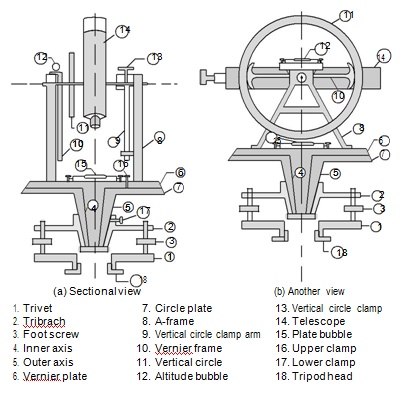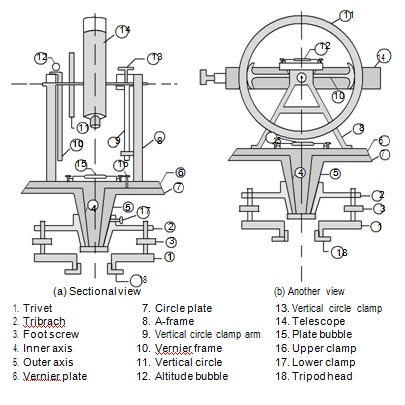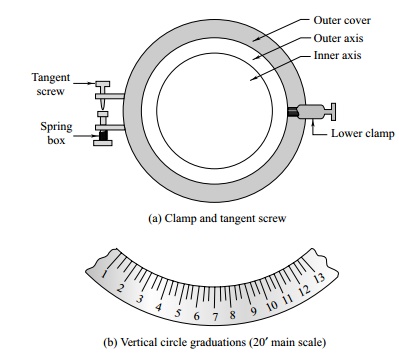Chapter: Civil Surveying : Theodolite Surveying
Vernier Theodolite

Vernier Theodolite
The vernier theodolite is also known as a transit. In a
transit theodolite or simply transit the telescope can be rotated in a vertical
plane. Earlier versions of theodolites were of the non-transit type and are
obsolete now. Only the transit theodolite will be discussed here.
Two different views of a vernier
theodolite are shown in Figs 6.1(a) and (b). The instrument details vary with
different manufacturers but the essential parts remain the same. The main parts
of a theodolite are the following.

(a) Sectional view (b) Another view
1. Trivet 7. Circle plate 13. Vertical circle clamp
2. Tribrach 8. A-frame 14. Telescope
3. Foot screw 9. Vertical
circle clamp arm 15. Plate bubble
4. Inner axis 10. Vernier
frame 16. Upper clamp
5. Outer axis 11. Vertical
circle 17. Lower clamp
6. Vernier plate 12. Altitude bubble 18. Tripod head
Fig.
6.1 Vernier
theodolite
Levelling head The
levelling head is the base of the instrument. It has the provi-sion to attach
the instrument to a tripod stand while in use and attach a plumb bob along the
vertical axis of the instrument. The levelling head essentially consists of two
triangular plates kept a distance apart by levelling screws. The upper plate of
the levelling head, also known as the tribrach, has three arms, each
with a foot screw. Instruments with four foot screws for levelling are also
available. In terms of wear and tear, the three-foot-screw instrument is
preferable. The lower plate, also known as the trivet, has a central
hole and a hook to which a plumb bob can be attached. In modern instruments,
the base plate of the levelling head has two plates which can move relative to
each other. This allows a slight movement of the level-ling head relative to
the tripod. This is called a shifting head and helps in centring the
instrument over the station quickly. The functions of the levelling head are to
support the upper part of the instrument, attach the theodolite to a tripod,
attach a plumb bob, and help in levelling the instrument with the foot screws.
Lower
plate The
lower plate, also known as the circle plate, is an annular,
Horizontal
plate with a beveled graduated edge fixed to the upper end of a hollow cylindrical
part. The graduations are provided all around, from 0 o to 360 o , in the
clockwise direction. The graduations are in degrees divided into three parts so
that each division equals 20¢. An axis through the centre of the plate is known
as the outer axis or the centre. Horizontal angles are measured with this
plate. The diameter of the lower plate is sometimes used to indicate the size
of or designate the instrument; for example, a 100-mm theodolite.
Upper plate The upper plate is also
a horizontal plate of a smaller diameter attached to a solid, vertical
spindle. The bevelled edge of the horizontal part carries two verniers on
diametrically opposite parts of its circumference. These verniers are generally
designated A and B. They are used to read fractions of the horizontal circle
plate graduations. The centre of the plate or the spindle is known as the inner
axis or centre. The upper and lower plates are enclosed in a metal cover to
prevent dust accumulation. The cover plate has two glass windows longer than
the vernier length for the purpose of reading. Attached to the cover plate is a
metal arm hinged to the centre carrying two magnifying glasses at its ends. The
magnify-ing glasses are used to read the graduations clearly.
Two axes or centres The inner
axis as mentioned earlier is the axis of the conical spindle attached to
the upper or vernier plate. The outer axis is the centre of the hollow
cylindrical part attached to the lower or circle plate. These two axes
coin-cide and form the vertical axis of the instrument, which is one of the
fundamental lines of the theodolite.

Plate
level The
plate level is a spirit level with a bubble and graduations on the glass cover.
A single level or two levels fixed in perpendicular directions may be provided.
The spirit level can be adjusted with the foot screw of the levelling head. The
bubble of the spirit level can be moved with the foot screws of the levelling
head, which is a very fundamental adjustment required for using the theodolite.
A small circular bubble may be provided for rough adjustment before levelling.
Index frame The index frame, also
known as a T-frame or vernier frame, is a T-shaped metal frame. The
horizontal arm carries at its ends two verniers, which remain fixed in front of
the vertical circle. These verniers are generally designedC and D. The vertical
leg of the T-frame, known as the clipping arm, has clipping screws with which
the frame can be titled. The altitude level is generally fixed on top of this
frame. When the telescope is rotated in a vertical plane, the vertical circle
moves and vertical angles are measured on the vertical circle with the help of
these verniers.
Standard or A-frame Two
standards in the shape of the letter A are attached to the upper plate.
The horizontal axis of the instrument is attached to these stan-dards. The
clipping arm of the index frame and the arm of the vertical circle clamp are
also attached to the A-frame. The A-frame supports the telescope and the
vertical circle.
Telescope The telescope is a vital part of the instrument. It enables one to see stations that are at great distances. The essential parts of a telescope are the eye-piece, diaphragm with cross hairs, object lens, and arrangements to focus the tele-scope. A focusing knob is provided on the side of the telescope. Earlier, external focusing telescopes were used. Today, only internal focusing telescopes are used in theodolites. These reduce the length of the telescope. The telescope may carry a spirit level on top in some instruments.
Vertical circle The
vertical circle is a circular plate supported on the trunnion or
horizontal axis of the instrument between the A-frames. The vertical circle has
a bevelled edge on which graduations are marked. The graduations are generally
quadrantal, 0 o -90 o in the four quadrants as shown in Fig. 6.2. The full circle
system of graduations can also be seen in some instruments. The vertical circle
moves with the telescope when it is rotated in a vertical plane. A metal cover
is provided to protect the circle and the verniers from dust. Two magnifying
glasses on metal arms are provided to read the circle and verniers. The cover
has glass or plastic windows on which the magnifiers can be moved.
Vertical
circle clamp and tangent screw The vertical circle is provided with a clamp and tangent screw as
in the case of the horizontal plate, Upon clamping the vertical circle, the
telescope cannot be moved in a vertical plane. The tangent screw allows for a
slow, small motion of the vertical circle.
Altitude level is used for levelling, particularly when
taking vertical angle observations.
A circular or trough
magnetic compass is generally fitted to the odolite for measuring the magnetic
bearing of lines. It is fitted on the cover of the horizontal
plates. Two plates with graduations are provided in the compass box for
ensuring that the needle ends are centred. The needle can be locked or released
by a pin. When released, the telescope can be turned in azimuth to make the
north end of the needle point to the north by making it read zero.
Tripod One accessory essential with
the theodolite is the tripod on which it is mounted when it has to be
used. The tripod head is screwed onto the base or the lower part of the
levelling head. Its legs should be spread out for stability. The legs of the
tripod are also used for rough levelling.
Plumb
bob A
heavy plumb bob on a good string with a hook at the end is required for
centring the theodolite over a station. The plumb bob is fixed to the hook or
other device projecting from the centre of the instrument in a central opening
in the levelling head.
Main circle and vernier graduations In most of the instruments, the vernier enables readings up
to 20? of the arc. This is made possible by marking the gradu-ations on the
circle and the vernier suitably as follows. As shown in Fig. 6.2(b), the main
circle is graduated into degrees and each degree is divided into three parts.
Each main scale division thus represents 2¢. For the vernier, 59 main scale
divisions are taken and divided into 60 parts. 59 main scale divisions form 59
¥ 20¢. Therefore, each vernier scale division represents 59 ¥ 20/60 minutes. As
you would have studied earlier, least count of the vernier = difference between
a main scale division and a vernier scale division = main scale division -
vernier scale division. Hence, in this case,
Least count = 20¢ - 59 ¥ 20/60 = 1/3 = (1/3) ¥ 60? = 20?
Thus the
least count of the vernier in common theodolites is 20?.
Related Topics